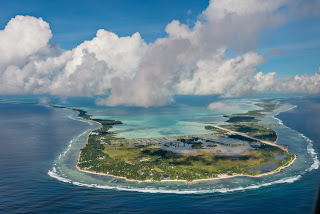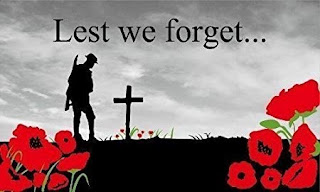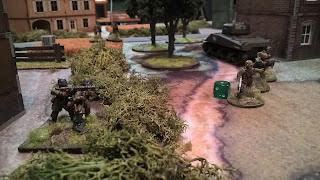Today marks the 100th
anniversary of the end of World War One. 11am on the 11th day of the
11th month the countries of with world decreed that enough was
enough and so formally stopped slaughtering each other. On a more personal level
would have been my parents 58th wedding anniversary. They made it to
57 with my mother passing away earlier this year.
My own interest in
the World Wars goes back to my childhood. The wars have always fascinated me,
they have shocked me, and they have enlightened me as to the propensity of mankind
to unleash unimaginable savagery upon itself.When growing up I
would usually spend my school holidays at my grandmother’s home in Timaru and
on each stay would pop down to the local model shop and purchase Airfix 1:72
scale WWII figures and model kits. My grandmother was horrified by my hobby. She
had lived though two world wars and to her war was not a game! It was real as were its consequences.
Nana was the youngest
of six children. She was sixteen or seventeen when the war broke out and in her
early twenties when it ended. Two of her brothers were gassed on the Western
front in World War One. She didn’t really much talk about them, though she used
to tell me stories of all other aspects of her life growing up in the early
twentieth century. Both, her brothers, like so many men who came back from the War to End all
Wars, died young, no doubt partly due to the wounds they’d received. Her future husband, my grandfather, had serviced on a minesweeper in the English Channel and North Sea and fought
at the Battle of Jutland where some of his crewmates were killed. I can’t begin
to imagine how bloody cold and dangerous it would have been patrolling those waters
for submarines in the depths of winter. Bugger that for a joke!
My other grandfather
died at the age of 86 in 1982 or 83. As a young man he served in the trenches
on the western front and only ever, to my mother’s knowledge, spoke of his experiences . That was one rainy summers day while he sat at the dinner table watching
me perched on a stool at our kitchen island trying to put together an Airfix
JU88 model. He was in his eighties and for the only time in his life he spoke to
his family about his experiences and especially his friends long gone- trying
to let my generation know of the futility of war. I really wish I had taped
that conversation.
For those that had
experienced, who had lived through the wars their perceptions were very
different to ours today. Often when
thinking of World War One we focus on the battles which, to us in New Zealand, were
fought at the other end of the world. However, it was also war that fought at
home by every family in the country. I can’t begin to imagine how hard life must
have been for people at home, the uncertainty of seeing loved ones ever again.
Of lives put on hold till the war, for good or ill, ended. People must have
dreaded the arrival of the postie. Was it good news? Was it bad?
Today, we know the
outcome of the war and it seems a foregone conclusion but for those experiencing
it day by day either in the various theatres of combat or at home the war and its
outcome was very, very uncertain. For those experiencing those days, and some were
terribly dark, life must have been bloody hard. People lived one day at a time,
lives were put on hold and many many lives were cruelly cut short; families and
communities were torn apart.
Some great innovations
came from the war and afterwards. People such as Tolkien were shaped by their experiences
in the trenches in World War One yet went on to great achievements that have
enriched all of humanity. I cannot help but wonder what great innovations in the
arts, in literature, in science, in medicine and technology were delayed or never
made because some of our brightest minds did not survive the war to make them. We will never know of the changes that could have
been made yet never were because a life was cut short in its prime. It truly was
a lost generation.
Both my grandfathers
belonged to this, a now long silent generation. They like most young men of
their generation answered the call up, enlisted and went to war. They left the
shores of a small, new country to travel across the world to fight on behalf of
an old one. For whatever reason that drove them to that decision they stepped
up to do what they feel needed to be done. They put aside their lives, their hopes,
their dreams, their families and loved ones, donned a uniform and left New
Zealand’s shores for Europe. Many of their friends that left with them did not
return.
Those that did survive
the war were not the same when they returned. They had changed, the world had
changed, their home towns and families had changed. The men and women that
returned were often barely recognisable and many struggled to assimilate to
life in peacetime. Some bore the scars of war outwardly, for others the scars
were on the inside, hidden and often not understood. Shell shock they called
it, we now call it Post Traumatic Stress Disorder. Men and women mentally damaged, haunted by their
experiences in the trenches, in the air, upon the seas. Families across the
country, just as were families across the world, were rent and broken. Some of those that served lived to a ripe old age
but many died young, their bodies or minds destroyed by their ordeal, their
youth stolen from them. Some haunted by their experiences took their own lives.
Others took out their anger and frustrations on their families, on their loved
ones. Wives and children often had to deal with puzzlement of a father’s anger
or distance, with their inability to emotionally connect with them, or coped
with with physical or mental abuse that was in part the result of a father or husband’s
wartime experiences. The generation that returned from the battlefields bore
their burdens silently and with stoicism but many many suffered.
I like to
think my grandfathers generation fought to change to world, to make the world a
better place for theirs and following generations. They were the Silent Generation
who stoically shouldered the burden of their ordeals. Most wouldn’t dwell on
those dark days. In fact for many in my grandfathers generation Armistice and ANZAC
days were not days to celebrate or to commemorate. Many did not march in the
parades, that came later. Instead you’d probably find them in a quiet corner of
a local pub or RSA with their mates sharing a quiet beer. They didn’t really talk
of their experiences but they would share a beer, renew a bond forged in the hells
of war, yet probably not talk about the way it had impacted on them.
As a child in the 1970s as the unpopular war
in Vietnam raged I recall ANZAC parades being disrupted by those, who are now
our babyboomers, antiwar protestors protesting against that war and trying to
change then world. There were verbal confrontations between World War One and Two veterans
and young men and women protesting against the futility of war. It seemed that
our ANZAC day almost became a day of national shame. But in more recent decades
there has been a change in attitude. Slowly yet surely as the numbers of
veterans declined growing numbers of children, young people and families, now attend
the Dawn Parad Services to commemorate, to reflect and to make sure those that went before
are not forgotten. That to my mind what Armistice day, and ANZAC day, should truly
be about.
The veterans of World
War One to my mind weren’t proud of their achievements, they did not glorify
the war. They fought in it, they survived it, they sure as hell didn’t want to
celebrate it. If anything they wanted to forget to put the horrors behind them,
get on with life and raise their families. The jingoism that existed in Europe
prior to World War One lead to unimaginable slaughter for four years, the survivors
didn’t want a bar of that but hoped to forge a better world, to
make sure that the sacrifice of the millions that died were not in vain.
Today, the voices
of the Lost Generation have fallen silent, soon too will those of the last
survivors of World War Two. Those that come after have a duty, a solemn duty ,to
honour their sacrifices, not glorify them, and pass on to future generations
the lesson of the Great War- NEVER AGAIN!
A lesson we seemingly have not learned and we seem doomed to forever
repeat. So it is with some alarm that I take note of the rise of nationalism
and popularism in the world today, are we doomed to repeat the 1930s with a new
rise of fascism? Have we learned nothing?
ANZAC and
Armistice Days are not a time for bravado, jingoism or pride, rather they are
days for solemn reflection and acknowledgement of the sacrifices of those that
served and the millions of casualties , both military and civilian, of those
two wars and to try to understand the unimaginable.
Today marks the 100th anniversary of the end of hostilities. It is a day to reflect on the sacrifices of those men and women of that long silent generation and to make sure that their sacrifices are never
forgotten that the lessons of this, the war to end all wars, are remembered and passed
on to future generations. The Great War was supposed to
be the war to end all wars but we know it was repeated on an even bigger scale barely
twenty years later. I sincerely hope we can one day learn the lesson whispered from
the graves in cemeteries and from the ghosts on battlefields across the world
and heed the voices of those that have gone before us of the futility of war
and listen as the wind whispers their final lament… NEVER AGAIN!
If you
could hear, at every jolt, the blood
Come gargling from the froth-corrupted lungs,
Obscene as cancer, bitter as the cud
Of vile, incurable sores on innocent tongues, --
My friend, you would not tell with such high zest
To children ardent for some desperate glory,
The old lie: Dulce et decorum est Pro patria mori.
-Wilfred
Owen- Dulce et Decorum Est
Craig




















































